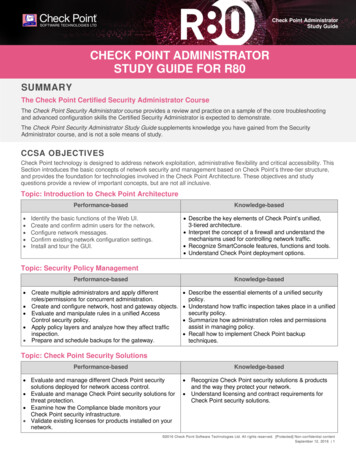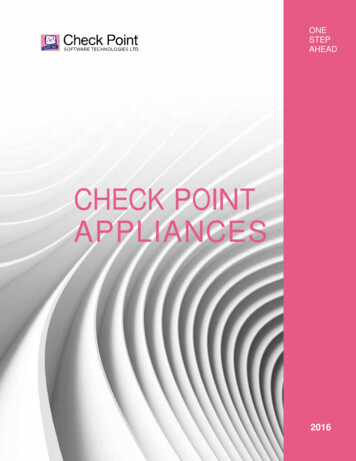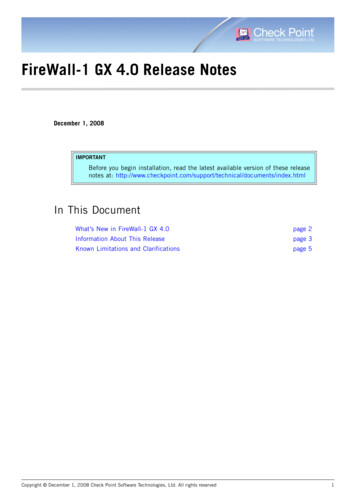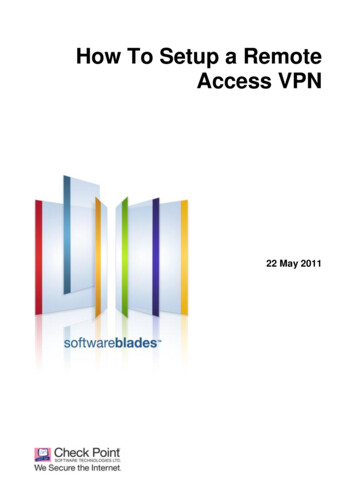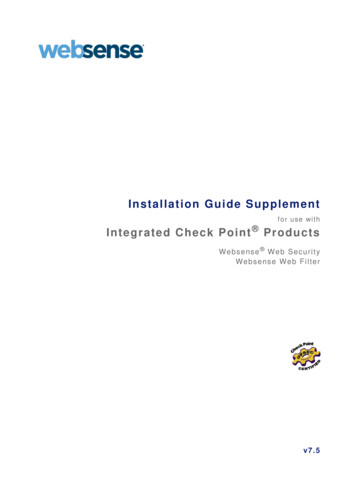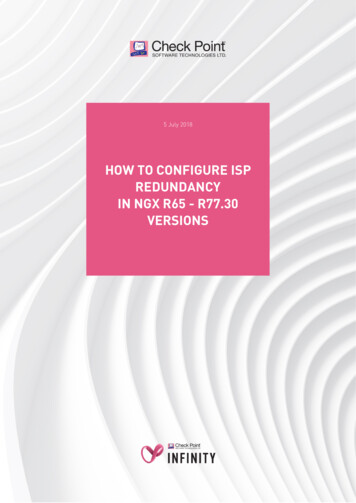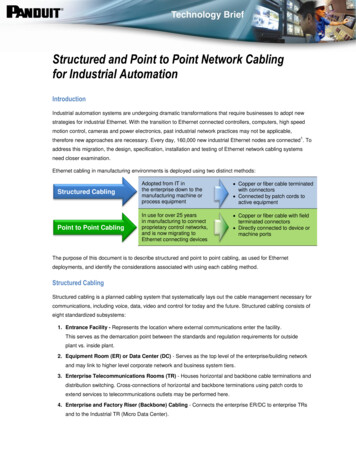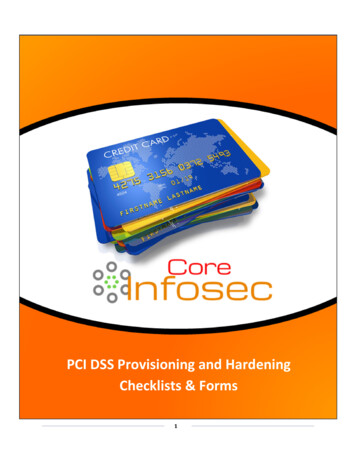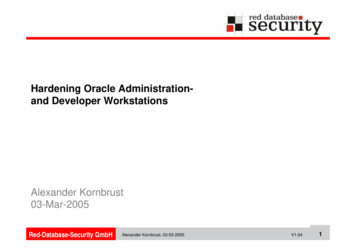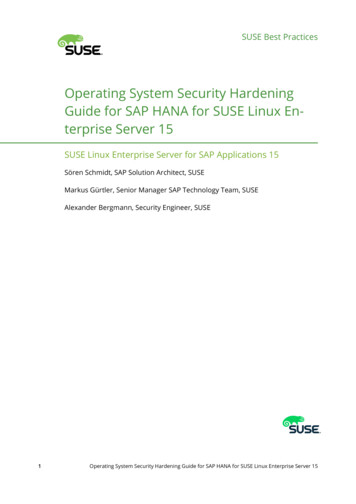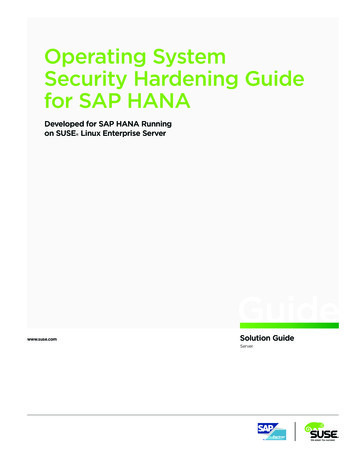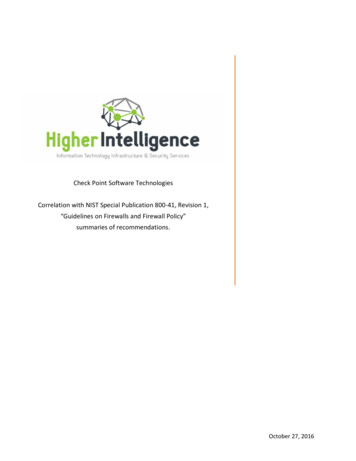
Transcription
Check Point Software TechnologiesCorrelation with NIST Special Publication 800-41, Revision 1,“Guidelines on Firewalls and Firewall Policy”summaries of recommendations.October 27, 2016
Table of contents:Page 1: Executive summaryPage 2: NIST 800-41 Revision 1 Section 2.4Overview of Firewall Technologies, Summary of Recommendations The use of NAT should be considered a form of routing, not a type of firewall.Page 3: Organizations should only permit outbound traffic that uses the source IP addresses in use by theorganization.Page 4: Compliance checking is only useful in a firewall when it can block communication that can beharmful to protected systems.Page 5: When choosing the type of firewall to deploy, it is important to decide whether the firewall needsto act as an application proxy.Page 6: Management of personal firewalls should be centralized to help efficiently create, distribute, andenforce policies for all users and groups.Page 7: NIST 800-41 Revision 1 Section 3.4Firewalls and Network Architectures, Summary of RecommendationsPage 8: Different common network architectures lead to very different choices for where to place afirewall, so an organization should assess which architecture works best for its security goals.Page 9: If an edge firewall has a DMZ, consider which outward-facing services should be run from the DMZand which should remain on the inside network. Do not rely on NATs to provide the benefits of firewalls. In some environments, putting one firewall behind another may lead to a desired security goal,but in general such multiple layers of firewalls can be troublesome.Page 10: NIST 800-41 Revision 1 Section 4.5 Firewall Policy, Summary of Recommendations An organization’s firewall policy should be based on a comprehensive risk analysis.Page 11: Firewall policies should be based on blocking all inbound and outbound traffic, with exceptionsmade for desired traffic.Page 12: Policies should take into account the source and destination of the traffic in addition to thecontent.Page 13: Many types of IPv4 traffic, such as that with invalid or private addresses, should be blocked bydefault.Page 14: Organizations should have policies for handling incoming and outgoing IPv6 traffic.Page 15: An organization should determine which applications may send traffic into or out of its networkand make firewall policies to block traffic for other applications.Page 16: NIST 800-41 Revision 1 Section 5.2.2 Policy ConfigurationPage 19: NIST 800-41 Revision 1 Section 5.2.3 Logging and Alerts ConfigurationPage 23: NIST 800-41 Revision 1 Section 5.5 ManagementPage 25: ConclusionOctober 27, 2016
Executive SummaryThis guide is intended to serve as a collection of general guidelines and principles that, if followed, willhelp to improve your company’s security posture. Please note that that both the NIST guidelines and thevendor’s best practices are generic in nature, and that there are no universal solutions when it comes tosecuring a particular infrastructure.This document is based on NIST Special Publication 800-41 Revision 1, (Guidelines on Firewalls andFirewall Policy), Check Point Software Technologies LTD. R77.X feature highlights and specificadministration recommendations.Check Point R77.X represents a comprehensive suite of infrastructure security solutions. They arecomprised of dedicated hardware devices, virtual appliances and software components called “blades”,each representing certain functionality. There are management and security blades that are designed tocover most aspects of information technology security.Although Check Point products could be deployed on a variety of operating systems, the preferred is theproprietary Gaia OS, created as a culmination of efforts in combining the best features of Nokia IPSOwith those of Check Point Secure Platform. The Gaia OS is a purpose-build hardened operating systembased on Linux. Particular steps taken by Check Point for the OS hardening could be found in theCP R77 Gaia Hardening Guide.pdf and are available for download on the UserCenter portal.As we follow NIST SP 800-41 Revision 1, various Check Point blades will be mapped to the summaries ofrecommendations provided therein. In your case, some of the functionality described will likely bedelegated to the devices, software or services by vendors other than Check Point, (i.e. VPN endpointdevices, client security, data loss prevention, etc.). In those cases, you should consider how the thirdparty solutions integrate with your Check Point security infrastructure components in order to maximizeyour effective coverage.Check Point Compliance blade could be utilized to automatically verify your configurations’ ongoingadherence to the NIST SP 800-41 Revision 1, as well as a number of other standards, such as PCI DSS orISO 27002, and to unambiguously highlight non-compliant systems and lapses in regulatoryrequirements.You can use the Compliance blade in the trial mode during initial stages of your security infrastructuredeployment and, should you find it useful, the blade could be licensed at a later date allowing youradministrators to easily spot deviations from policies required by regulations you are subjected to.1 PageVladimir Yakovlev
NIST 800-41 Revision 1 Section 2.4 Overview of Firewall Technologies, Summary of Recommendations The use of NAT should be considered a form of routing, not a type of firewall.Check Point firewalls not deployed in a transparent bridge mode are capable of routing as well as NATand PAT traffic manipulation. While masquerading does help in reducing exposure of address rangessusceptible to attacks, it is a task executed by the routing daemon of the firewalls. NAT could be definedeither by enabling it in the properties of the objects,in which case the NAT rule will be created automatically, (e.g. Rules No. 2-6 below), or by manuallycreating NAT rules in the Smart Dashboard\Firewall\NAT policy, (e.g. Rule No. 1):2 PageVladimir Yakovlev
Organizations should only permit outbound traffic that uses the source IP addresses in use by theorganization.Check Point firewalls are capable of enforcing Anti-Spoofing on all of their interfaces. Only IP addressesthat are either tied to topology of the interfaces or are manually defined could traverse the firewall:If the interface in question is expected to accept traffic not only from the network to which it belongs,exit this menu, create a group object containing all other objects that should be allowed to traversefirewall from this interface, return to this menu and check the radio button “Specific”, then browse tothe group object created earlier and choose it to populate the box.For clarification about the function of the “Interface leads to DMZ” checkbox and to see what policiesand protections are available for the DMZ designated interfaces, see sk108057.3 PageVladimir Yakovlev
Compliance checking is only useful in a firewall when it can block communication that can beharmful to protected systems.Check Point IPS blade is capable of this function. Found in Smart Dashboard\IPS\Protections\By Type\Protocol Anomalies, particular violation actions are either already set to “protect,” or could be enabledin either one of two policies created by default, or in a new policy that could be created from scratch, orby cloning a pre-existing one. See the example below for protection against a Non-Compliant SSL:It is fairly common for some of the modern useful applications to be out of compliance with RFCs.Should this be an issue with some of the valid and expected traffic, you have the ability to defineexceptions under the “Network Exceptions” tab of a particular protection.4 PageVladimir Yakovlev
When choosing the type of firewall to deploy, it is important to decide whether the firewall needsto act as an application proxy.Check Point firewalls could act in the capacity of HTTP/HTTPS proxies (see sk110348), as well as servingas MTAs and filters for the email traffic. Shown here is the “Anti-SPAM and Mail” overview page withnested links to settings of its components:Security functions are performed by “IPS”, “Threat Prevention” and “Anti-SPAM and Mail” blades.Even if these functions are sufficient for your purposes, you will be better served by using third party,custom built application proxies with extended functionalities by forwarding identified traffic to externalappliances.5 PageVladimir Yakovlev
Management of personal firewalls should be centralized to help efficiently create, distribute, andenforce policies for all users and groups.Check Point SmartEndpoint Server allows for centralized management of personal firewalls. NIST definespersonal firewalls as a “software that runs on a desktop or laptop PC with a user-focused operatingsystem such as Microsoft Windows or Mac OS X”.Check Point endpoint security solutions include data security, network security, advanced threatprevention, forensics and remote access VPN for complete endpoint protection. To simplify securityadministration, the endpoint suite products can be managed using a single console:Please note that when using centralized endpoint security blades, your tradeoff is the speed ofdeployment of new OS versions or service packs, as typically the security vendors tend to trail OSvendors by a few months to confirm stability of their solutions. This does not affect deployment orinstallation of regular security patches for OS, or software installed on the endpoints.Given the interdependency between OS and the Endpoint Security Client blades, it is prudent to definecontrol groups to test the application of endpoint policies in order to verify their functionality beforedistribution to the intended scope of desktops and laptops.Same is applicable to the installation of security patches and updates for the operating systems in orderto assure that there is no negative impact on functionality of the Endpoint Security Client softwareblades.6 PageVladimir Yakovlev
NIST 800-41 Revision 1 Section 3.4 Firewalls and Network Architectures, Summary of Recommendations In general, a firewall should fit into a current network’s layout. However, an organization mightchange its network architecture at the same time as it deploys a firewall as part of an overallsecurity upgrade.If need be, Check Point firewall could be deployed in the “Bridge Mode”, acting as a two-port switch thatbelongs to the same broadcast domain. These blades are supported in the Bridge Mode when used oneither physical or virtual systems:Supported BladeFirewallIPSURL FilteringDLPAnti-Bot and Anti-VirusApplication ControlHTTPS InspectionIdentity AwarenessThreat EmulationQoSClient AuthenticationUser AuthenticationSupports Gateways in Bridge Mode Supports Virtual Systems in Bridge esYesNoNoYesNoNoNoYou can use any two of the interfaces, either physical or VLAN, in order to accommodate thisconfiguration. This option is valuable if you are trying to implement security functions described above inthe existing network without changing your routing schema on certain production segments of yournetwork.It is important to note that you can use the same firewall appliance or cluster for both the routed andBridge Mode implementations at the same time.A newly designed infrastructure, or one undergoing modification, is better served by creating networksegmentation and thus should rely on routed firewall implementation strategies.Check Point physical and virtual appliances support static and dynamic routing, as well as policy-basedrouting, allowing for flexibility of conditional traffic flow manipulation.Please note that dynamic routing should be used with extreme care, as routing changes propagated fromone of the network segments may inadvertently affect the functionality of all other segments dependenton the firewall. Additionally, dynamic routing coupled with loosely defined Anti-Spoofing and SecurityPolicy rules may result in sensitive data being redirected to unintended destinations.7 PageVladimir Yakovlev
Different common network architectures lead to very different choices for where to place afirewall, so an organization should assess which architecture works best for its security goals.Traditionally implemented at the perimeter, firewalls are now increasingly required to protect internalnetwork segments, virtual and cloud-based components of hybrid infrastructures.Due to proliferation of laterally propagated threats (such as ransomware), any single broadcast domaincould be exposed. While there are Network Intrusion Prevention systems available to address this typeof attacks, they are outside of the scope of this document.To mitigate the impact of laterally propagating attacks by using Check Point firewalls, one of the followingtwo approaches may be implemented:1. If the broadcast domain is served by multiple distribution switches, use Bridge Mode deploymentto pass the traffic from core to the distribution switches through a firewall equipped with CheckPoint Antivirus and Threat Prevention components enabled. It would make sense to distributeendpoint connections to the switches serving same broadcast domain in such a way, thatmembers of same departments or hosts serving same application are connected to differentswitches.2. Assign endpoints that belong to each department or hosts serving same application to two ormore broadcast domains and route them through the firewall with Check Point Antivirus andThreat Prevention components enabled.VMware VSX simplifies these approaches as it allows for the spawning of multiple fully capable firewallinstances on shared hardware with each configured to provide highly-tuned protection to the hostsbehind them.Virtualization and cloud solutions are increasingly taking advantage of the distributed network overlaysthat create virtual networking environments on top of the existing switching and routing hardware.Commonly referred to as SDN (Software Defined Network), this technology is designed to helporganizations take advantage of automation and simplify the scalability of infrastructure.From a security point of view, this represents challenges related to the fact that the virtual networkoverlay is invisible to conventional firewalls, as VXLAN traffic is tunneled through those. Not long afterthis technology has taken hold, security vendors have responded with solutions tailored to address therequirements of massively scalable virtual infrastructures.Check Point vSEC* for VMware NSX, AWS and Azure, is designed to integrate with on premise or cloudofferings and, when combined with micro-segmentation, provides the same level of security to virtualand cloud environments as do conventional firewalls to the traditional hardware-centric deployments.**Additional benefit of employing vSEC is that common security policies could be applied to the instancesprotecting physical and virtual infrastructures, ensuring adherence to the corporate security standardsand a consistent logging format. This allows for simplified troubleshooting and better decision making bysecurity administrators.*Check Point vSEC**VMware Micro-Segmentation overview8 PageVladimir Yakovlev
If an edge firewall has a DMZ, consider which outward-facing services should be run from theDMZ and which should remain on the inside network.Depending on your firm’s overall security stance, you may choose to place application (reverse) proxies inthe DMZ and to enable filtering on both ingress and egress traffic. In this case, the outward-facingservices are going to be located on the “inside” of the firewall. This solution introduces one more hurdlefor attackers to overcome. Some of the application proxies are capable of decrypting the traffic securedby the SSL/TLS encryption. If such a proxy is implemented, its egress traffic could be subjected to theIPS/IDS, antivirus and threat detection analysis that otherwise would not be possible.Additionally, if a third-party VPN solution is being utilized, the VPN endpoint appliance could be placed inDMZ as well, for similar purposes: the IPSEC or SSL VPN traffic, normally encapsulated, will be decodedand visibility of the security solution analyzing it will be increased. Note that whenever traffic traversingVPN is protected by SSL/TLS encryption, its payload is still hidden from the firewall’s threat preventioncomponents.To achieve maximum visibility into the traffic traversing the firewalls while at the same time notoverloading it with processing intensive decryption tasks, use application proxies with SSL/TLS decodingcapability and VPN endpoints in the DMZ loops, (one firewall interface in DMZ and one on the inside),outbound SSL/TLS visibility appliances on the inside loops and outward looking servers on dedicatedinside zones. This, with the rules permitting traffic to and from devices behind various interfaces of thefirewall(s) to appropriate destinations on dedicated ports, will maximize the efficiency of processing andprovide excellent visibility and logging depth. Do not rely on NATs to provide the benefits of firewalls.See Page 2, “The use of NAT should be considered a form of routing, not a type of firewall.” In some environments, putting one firewall behind another may lead to a desired security goal,but in general such multiple layers of firewalls can be troublesome.Utilization of multiple layers of firewalls is largely unavoidable in the highly virtualized dynamicenvironments where solutions such as vSEC or other virtualization firewalls are implemented, or wherethe networks are heavily segmented to increase the overall security posture. When executed withforethought, including provisions for future expansions, alterations and increase in traffic volume, it ispresently the desired approach. Case in point would be a peripheral firewall, (or cluster), with relativelysimple rule-base designed to effectively route high volumes of filtered inbound traffic to a second tier ofthe firewalls, each configured to provide specific protections to particular applications. This second tierof firewalls will perform the heavy lifting of IDS/IPS, antivirus, etc. and hand the processed traffic over tothe vSEC instances running on virtual infrastructure.9 PageVladimir Yakovlev
NIST 800-41 Revision 1 Section 4.5 Firewall Policy, Summary of Recommendations An organization’s firewall policy should be based on a comprehensive risk analysis.An ongoing process of risk analysis and remediation should be implemented to allow for continuousassessment of threats and vulnerabilities, existing countermeasures available for mitigation, and theimpact caused by compromised systems or data.Well documented, frequently reviewed and updated firewall policies should be reflective of emergingnew threats, discovered vulnerabilities and changing requirements of organization’s networks andapplications.Risk analysis is outside of the scope of this document. NIST Special Publication 800-30 Revision 1 could beused to develop an organization-specific risk management policy.10 P a g eVladimir Yakovlev
Firewall policies should be based on blocking all inbound and outbound traffic, with exceptionsmade for desired traffic.Check Point firewalls are, by default, configured to “Deny All” but the traffic defined in “Implied” and“Explicit” rules.Implied rules are those that take under consideration, for example, routing protocols or secure controlconnections necessary for remote administration. These could be found in “Global Properties\Firewall”.You have the ability to disable all of the implied rules and to replace them with your own explicit ruleswithin the policy.Note that the traffic matching implied rules is not logged by default. However, you have the ability toenable logging for either all of the implied rules, (by checking “Log Implied Rules” checkbox in “GlobalProperties\Firewall”), or for select ones (by creating redundant explicit rules with
Oct 27, 2016 · firewall from this interface, return to this menu and check the radio button “Specific ”, then browse to the group object created earlier and choose it to populate the box. For clarification about the function of the “

